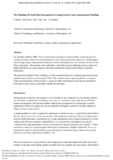JavaScript is disabled for your browser. Some features of this site may not work without it.
| dc.contributor.author | Reilly, C. | |
| dc.contributor.author | Green, N. R. | |
| dc.contributor.author | Jolly, Mark R. | |
| dc.contributor.author | Gebelin, J. C. | |
| dc.date.accessioned | 2016-10-28T10:53:55Z | |
| dc.date.available | 2016-10-28T10:53:55Z | |
| dc.date.issued | 2013-04-10 | |
| dc.identifier.citation | C. Reilly, N.R. Green, M.R. Jolly, J.-C. Gebelin, The modelling of oxide film entrainment in casting systems using computational modelling, Applied Mathematical Modelling, Volume 37, Issues 18–19, 1 October 2013, Pages 8451-8466 | en_UK |
| dc.identifier.issn | 0307-904X | |
| dc.identifier.uri | http://dx.doi.org/10.1016/j.apm.2013.03.061. | |
| dc.identifier.uri | https://dspace.lib.cranfield.ac.uk/handle/1826/10903 | |
| dc.description.abstract | As Campbell stated in 2006, “the use of entrainment models to optimise filling systems designs for castings has huge commercial potential that has so far being neglected by modellers”. In this paper a methodology using computational modelling to define entraining events and track the entrained oxide films is presented. Research has shown that these oxide films present within the casting volume are highly detrimental to casting integrity, thus their entrainment during mould filling is especially undesirable. The method developed for the modelling of oxide entrainment has been validated against previously published data by Green and Campbell (1994) [31]. The validation shows good quantitative correlation with experimental data. However there is scope for further development which has the potential to both improve the accuracy and further validate the technique. | en_UK |
| dc.language.iso | en | en_UK |
| dc.publisher | Elsevier | en_UK |
| dc.rights | Attribution-Non-Commercial-No Derivatives 3.0 Unported (CC BY-NC-ND 3.0). You are free to: Share — copy and redistribute the material in any medium or format. The licensor cannot revoke these freedoms as long as you follow the license terms. Under the following terms: Attribution — You must give appropriate credit, provide a link to the license, and indicate if changes were made. You may do so in any reasonable manner, but not in any way that suggests the licensor endorses you or your use. Information: Non-Commercial — You may not use the material for commercial purposes. No Derivatives — If you remix, transform, or build upon the material, you may not distribute the modified material. No additional restrictions — You may not apply legal terms or technological measures that legally restrict others from doing anything the license permits. | en_UK |
| dc.subject | Modelling | en_UK |
| dc.subject | Oxide films | en_UK |
| dc.subject | Casting | en_UK |
| dc.subject | Defects | en_UK |
| dc.subject | Entrainment | en_UK |
| dc.subject | Optimisation | en_UK |
| dc.title | The modelling of oxide film entrainment in casting systems using computational modelling | en_UK |
| dc.type | Article | en_UK |
Files in this item
This item appears in the following Collection(s)
-
Staff publications (SATM) [4364]
